You can write code without a code review tool. But why would you, when you can move faster and stay confident with one?
As GenAI adoption grows, many teams still rely on manual reviews or developers checking their own code. You might be one of them, and that’s okay. Human reviews will always have their place, but at scale, they can be time-consuming and prone to oversight. That’s where automation comes in.
According to Aikido’s 2026 State of AI in Security & Development report, 73% of teams still rely on manual reviews or developer self-checks. Automated tools can help ease that workload, catching what humans might miss and ensuring faster, more consistent results.
If AI is already helping you write code faster, it makes sense to let it assist in reviewing it too, so you can focus your cognitive effort on what matters most.
Today’s review tools go beyond the basics, offering AI automation, real-time feedback, and smooth integrations. We’ve done the research to highlight the best standout options, so you don’t have to.
We’ll start with an overview of the leading tools, then break down the best choices for startups and enterprises. You can skip to your preferred use case below if you’d like.
- 5 Best Code Review Tools for Agile Teams and Startups
- 3 Best Code Review Tools for Enterprise Development Teams
What Are Code Review Tools?
Code review tools are all about making life easier for development teams by helping them spot issues and improve code quality before shipping. They let you review code for bugs, security gaps, or anything that doesn’t align with your standards.
In 2026, that means more than just finding bugs or bad code. Modern code review tools now use AI to suggest fixes, flag potential security vulnerabilities, and analyze code patterns across repositories to catch problems before they even reach production.
And because development has become platform agnostic, today’s tools integrate with a variety of version controls and IDEs, reviewers can leave comments, approve changes, or generate automated insights without ever leaving their environment.
At the end of the day, the best code review tools help teams write better code faster, while keeping everything clean. Code review is less about finding mistakes and more about building stronger, more efficient and collaborative engineering habits together.
How To Choose Code Review Tools for Your Workflow
Not every code review tool fits every team. The right choice depends on your workflow, your stack, and how your engineers actually collaborate.
Here’s what to look for:
1. Integration With Your Existing Stack (IDE, Version Control, Etc)
The best code review tools fit naturally into your ecosystem whether that’s GitHub, GitLab, Bitbucket, or a self-hosted CI/CD pipeline. You shouldn’t have to change your workflow just to use them.
Also should make your team faster. No learning curve. If your choice requires weeks to onboard and configure. Please think again.
2. AI Assistance and Automation
Modern teams are embracing AI-assisted reviews to catch logic flaws, generate improvement suggestions, and reduce review fatigue. Look for tools that learn from your codebase and context, not just static rules.
3. Customization and Context
Every team has its unique identity. From naming conventions to architectural choices. The best tools let you define these rules so your reviews stay high-signal and relevant.
4. Collaboration Experience
Reviews should feel like teamwork, not a checklist. Pick tools that support threaded discussions, inline comments, and asynchronous reviews (especially important for distributed teams).
5. Scalability and Performance
As your repositories grow, review tools need to handle large diffs, monorepos, and concurrent pull requests without slowing your CI/CD pipeline.
6. Support for Security Standards
When choosing a code review tool, support for security standards should be non-negotiable.
Modern engineering teams aren’t just reviewing for clean syntax anymore, they’re reviewing for compliance, consistency, and security posture. The right tool helps you enforce frameworks like OWASP Top 10, CWE, CIS Benchmarks, or even your own internal standards without slowing development down.
Tools with built-in SAST-like checks or integrations with your DevSecOps pipeline can automatically flag insecure patterns, dependency risks, or policy violations as part of the review. This prevents issues from slipping into production and keeps your codebase aligned with your organization’s governance requirements.
Top 7 Best Code Review Tools of 2026
1. Aikido Security

Aikido Security’s Code Quality capability incorporates AI-powered code review. It’s a modern tool designed to make reviews faster and easier, with AI-driven insights and seamless integration into your version control and IDEs. This ensures your code is reviewed at every stage of the Software Development Lifecycle (SDLC).
Aikido Code Quality brings AI-native intelligence into your development workflow by providing:
- Instant, context-aware feedback in pull requests
- Adaptive learning that understands your codebase and improves with past reviews
- Custom rule definitions, giving developers focused, high-signal comments that actually matter
For example, if want a rule that says:
Allow only Alpine base images in Dockerfiles as base images
You can simply create one by giving compliant and non compliant examples so Aikido code quality knows what to look for aside from industry best practices.

Why developers like Aikido:
Beyond custom rules, one of the major challenges developers share with using code review tools is navigating their specific context. Every organization is unique, and Aikido understands that, which is why it enables you to teach it your team's coding guidelines, best practices and exceptions. It adapts to your organization’s DNA.
You can add context like:
“We store dates as UTC in the DB but always display in user’s local time; all conversion logic is in utils/timezone.js so don’t flag timezone conversions as redundant”
And even tailor it to specific repositories:

By adding this kind of context, Aikido’s AI-powered review understands your codebase’s unique rules and intent, so it avoids false positives and focuses feedback where it truly matters.
In addition, with its system & language-agnostic nature, Aikido Security’s code quality tool gives you the flexibility to leave comments, approve changes, or generate automated insights without ever leaving your environment. Making it one of the best code review tools for those wanting a mix of automation and adaptability.
Pros:
- The AI code reviewer handles repetitive tasks, freeing up time for complex work.
- Works out of the box, across your stack
- Integrates with major version controls, so teams can use existing repositories.
- Supports multiple languages from Java to Ruby
- Custom rules let you tailor the review process to your needs.
- Manage multiple repositories from one place.
- Context-aware analysis improves code quality with smarter suggestions and 1-click fixes.
- Analytics dashboard shows key metrics to track performance and code quality.
Customer reviews:
- “Game changing tool for shift left security mindset” – A G2 reviewer
- "Rapid setup (minutes), human support (no bots) and a fantastic solution." – A G2 reviewer
- “Aikido saves hundreds of hours of developers time by catching and filtering” – Gartner
- Many note that it significantly reduces review fatigue and helps junior developers learn best practices through detailed explanations in PRs.
In nutshell Aikido saves you time and cost as you would want your code review to.
2. Graphite
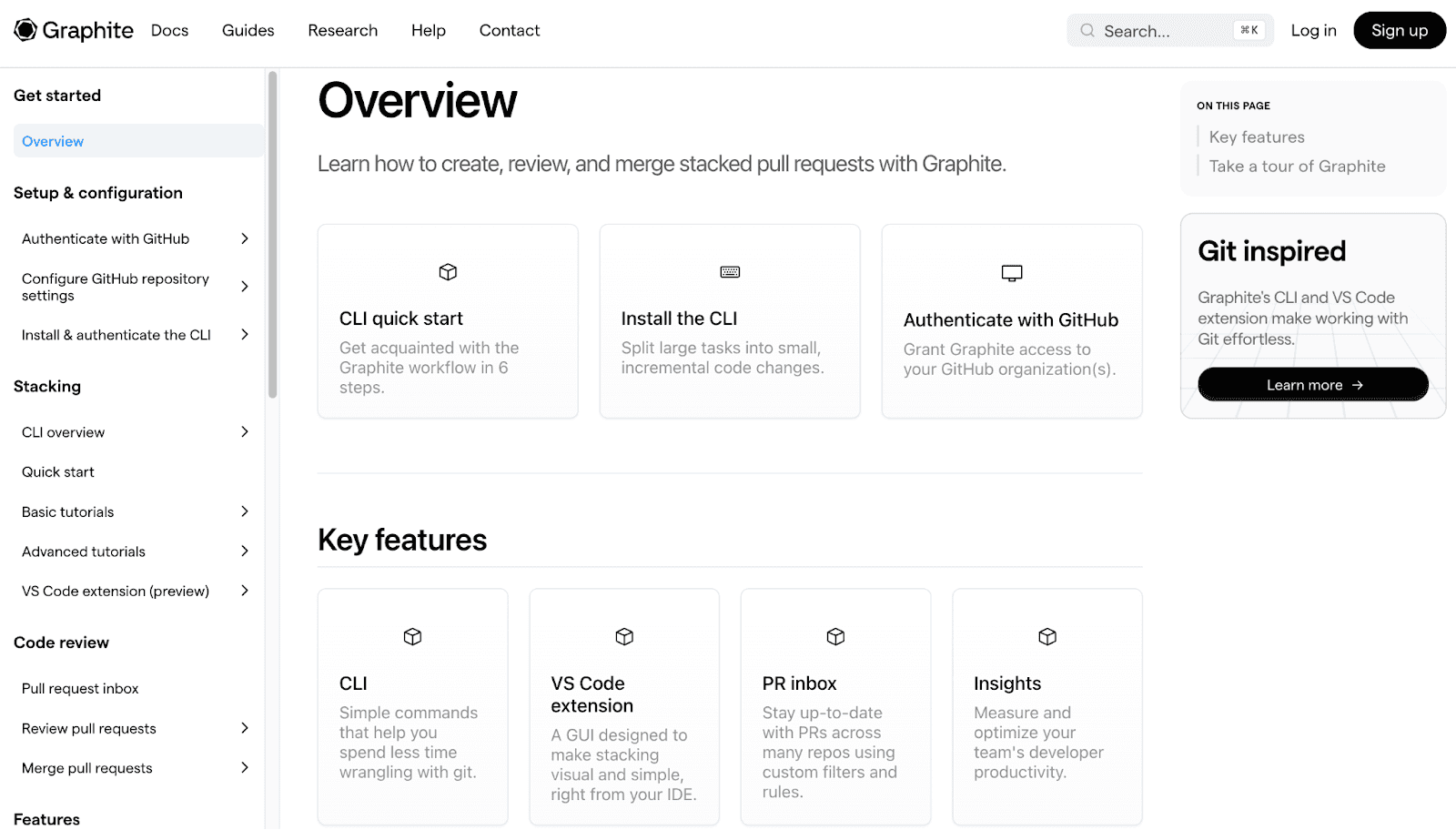
Graphite is a platform designed to simplify code reviews, especially for teams using GitHub. Its stacked pull request feature lets teams break complex changes into smaller, more manageable updates for simpler reviews and faster approvals.
The platform offers tools to minimize context switching and maintain focus during the review process.
Why developers like Graphite:
Developers gravitate toward Graphite because it introduces advanced review mechanics without disrupting existing Git-based workflows.
Its defining feature “stacked pull request workflow” — allows developers to break large features into smaller, reviewable chunks. Instead of submitting one massive PR, Graphite lets you create incremental changes that build on each other using commands like gt create, gt modify, and gt sync.

Pros:
- Offers stacked PRs to break down complex changes, speeding up approvals.
- Shows a side-by-side view to keep everything in one place, reducing distractions.
- Features a simpler design that quickly highlights bugs and potential issues.
- Includes merge checks that verify quality standards before merging code.
- Integrates smoothly with GitHub for easy use of existing tools.
Cons:
- Stacked PRs may be a learning curve for teams used to traditional Git workflows.
- Limited compatibility outside GitHub.
- A smaller community means fewer third-party integrations.
Customer reviews:
“I’ve enjoyed using Graphite so much that I wrote my own Emacs integration for it” - Graphite case study.
Pricing: Free for personal projects, $20 per user/month upwards for paid plans.
3. CodeRabbit
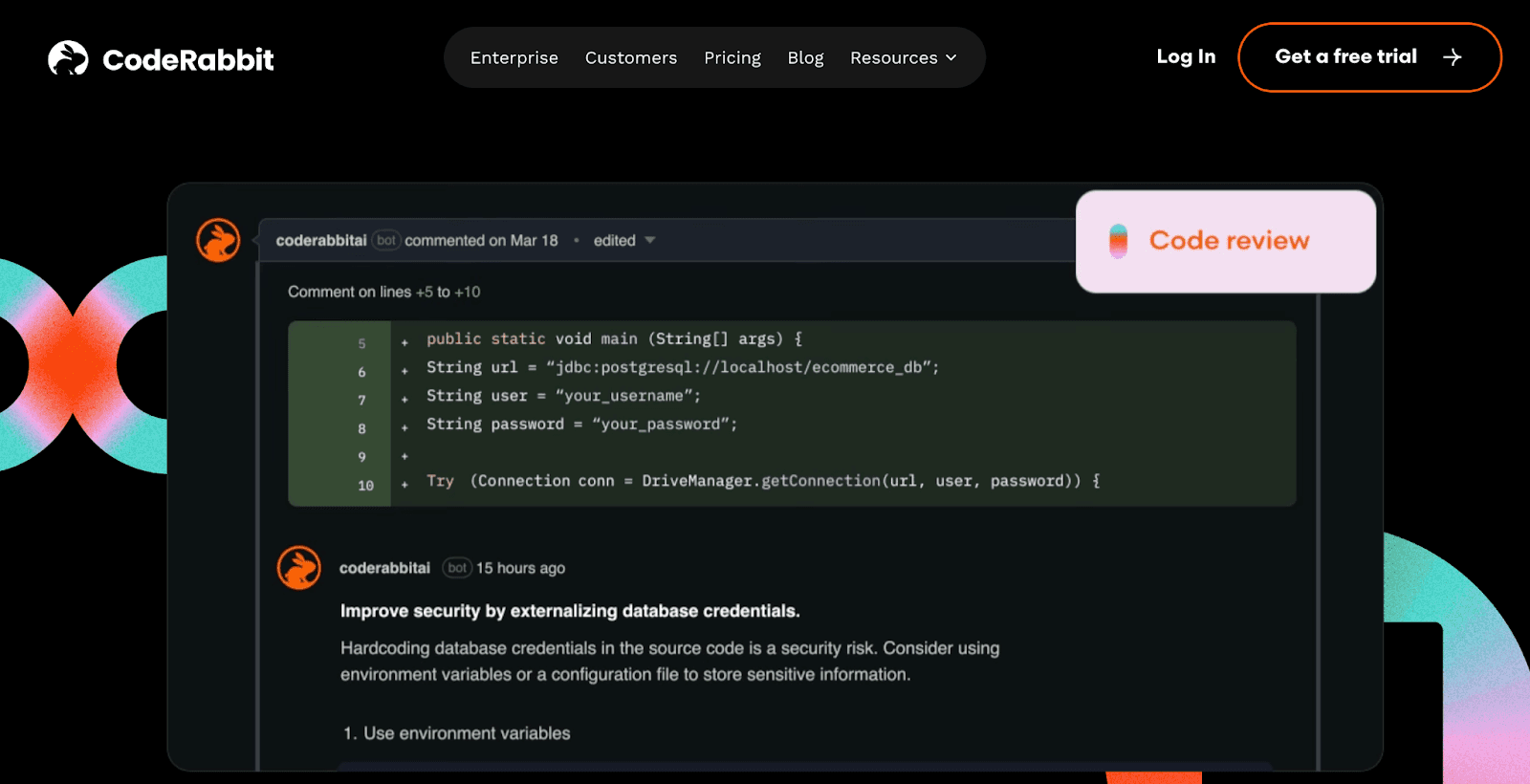
CodeRabbit is an AI-driven code review tool that aims to streamline the review process for development teams. It provides automated feedback, fastcollaboration, and customizable rules to meet project standards. With Pull request, IDE and CLI integration, CodeRabbit meets developers where they are at in producing code.
Why developers like CodeRabbit:
Developers appreciate CodeRabbit for its precision and signal-to-noise ratio. Also its GitHub-native UX makes it feel like an extension of the PR workflow, not an external reviewer.

CodeRabbit uses advanced machine learning models trained on a vast dataset of code to provide highly accurate and relevant feedback. However, it is designed to complement, not replace, human review.
Pros:
- AI-powered reviews deliver line-by-line feedback, helping spot bugs and suggest improvements.
- Step-by-step reviews catch issues early by analyzing code changes with every commit.
- Committable suggestions let developers make changes directly within the tool.
- Customizable review rules set to project-specific standards.
- GitHub integration ensures a smooth workflow.
Cons:
- Pricing may not suit small teams or individual developers.
- Suggestions can sometimes lack enough context to be fully reliable.
- Performance issues, like occasional slowdowns, can interrupt the review process.
- The interface may feel unintuitive for some users, making navigation tricky.
Customer reviews:
- “Developers highlight CodeRabbit’s clean GitHub integration, context-aware AI feedback, and ability to catch subtle logic bugs that conventional linters miss.” – G2 review
- A user on Apidog tried CodeRabbit and found its learning curve to be gentle
Pricing:
Free for PR summarization, $15 per user/month upwards for paid features.
4. SonarQube Server
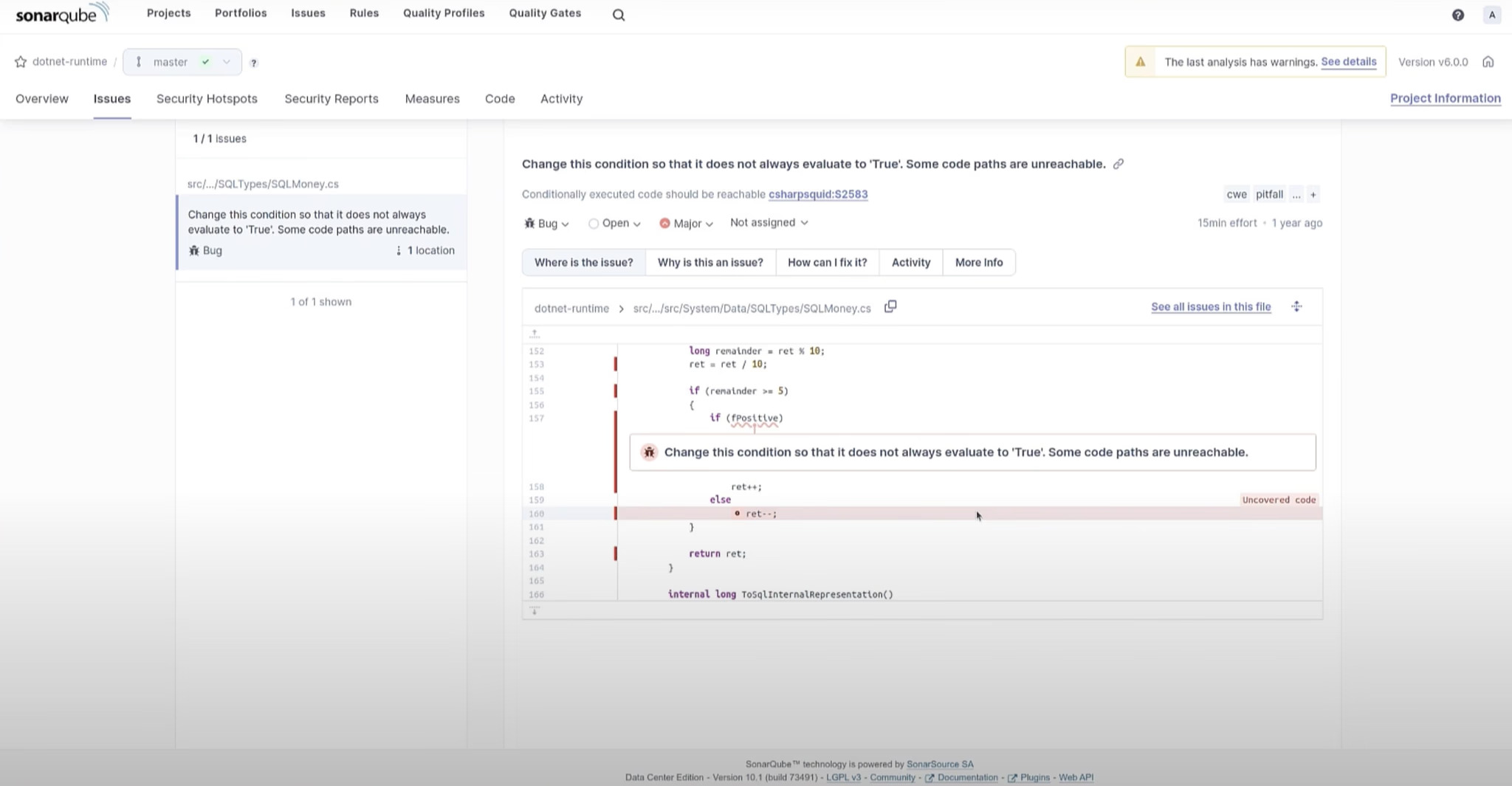
SonarQube is one of the leading code review tools that helps developers keep their code clean and secure. It highlights issues like weak points, code smells, and technical debt across many programming languages.
With easy integration into CI/CD pipelines, it maintains code quality at every stage of development. SonarQube’s clear dashboards and reports make it simple for teams to track progress and focus on key improvements.
Why developers like SonarQube:
Developers love and trust SonarQube for two main reasons:
- It is a battle-tested static analysis tool. It's been around the block for more than a decade.
- It’s open source at its core. That openness means teams can self-host, customize, and extend it to fit their own workflows and compliance needs without vendor lock-in.
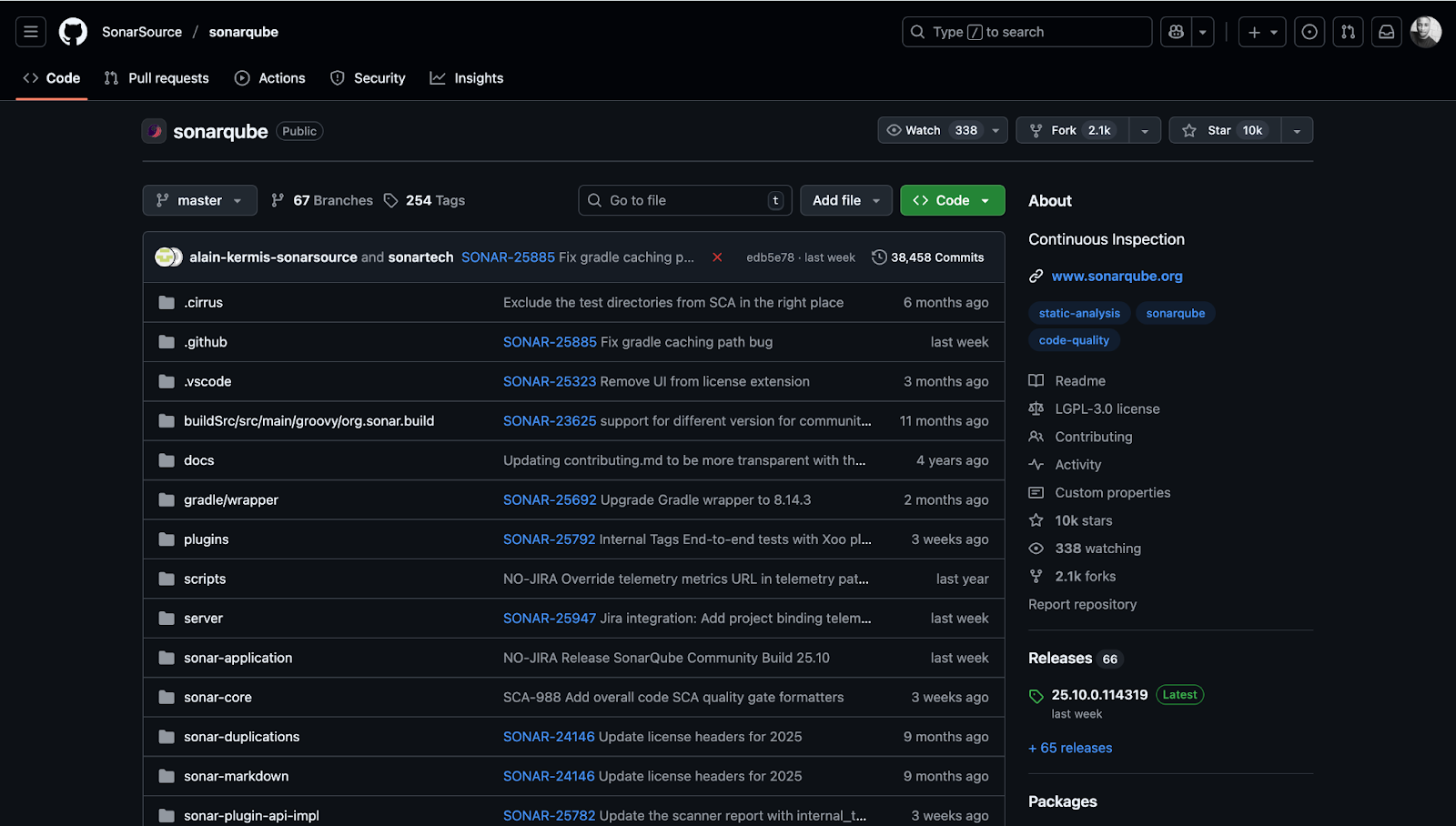
Pros:
- Identifies bugs, vulnerabilities, and code smells in various languages.
- Integrates with CI/CD tools like Jenkins, Azure DevOps, and GitLab CI for automated checks.
- Customizable quality gates reduce technical debt by setting merge/deployment rules.
- Dashboards track trends and highlight areas for improvement.
- Supports over 25 programming languages.
- Open-source with a large community contributing plugins and extensions.
Cons:
- Too complex for smaller projects or teams.
- Setup requires time and technical expertise, especially for self-hosted versions.
- Some features are limited without CI tool integration.
- Can be resource-intensive, requiring stronger server infrastructure for large projects.
Customer reviews:
SonarQube reviews are riddled with mixed feelings. Some swear by it, others curse at it:
- One Reddit user said: “SonarQube is complete dog sh*t.”
- A software advice reviewer said: “Perfect for detecting unit test coverage”
You decide.
Pricing:
- Free with limited features for developers that want to try.
- Team plans are paid and start at $32 per month.
5. Snyk
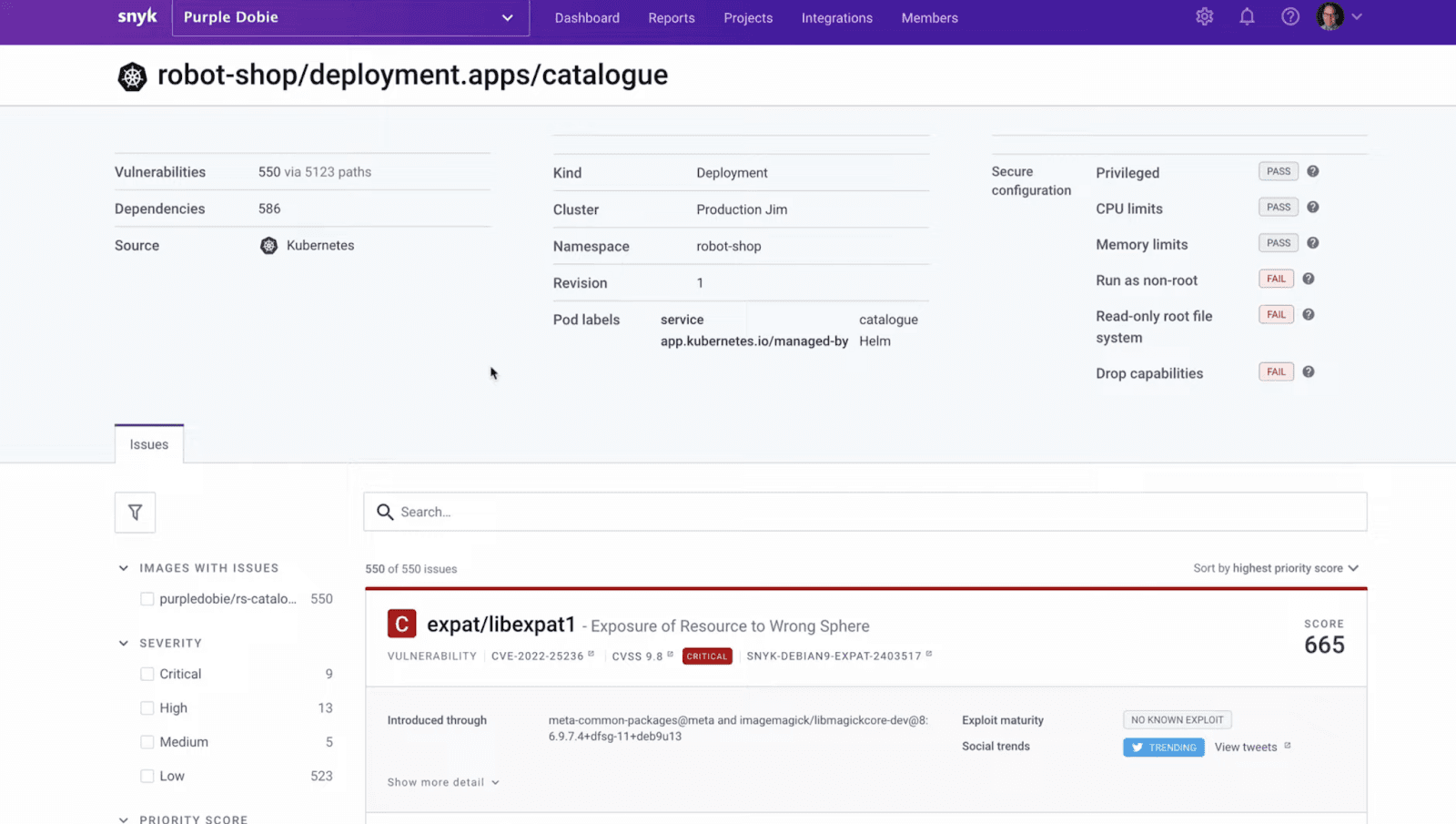
Snyk is a developer-friendly security tool designed to identify and address vulnerabilities in code and dependencies. It integrates with popular tools offering real-time scanning and open-source analysis to raise project security. With a simple design and proactive approach, Snyk simplifies managing vulnerabilities for teams of all sizes, though larger organizations might find its features lacking.
Why developers like Synk:
Developers like Snyk because it brings security directly into the development workflow.
Pros:
- Works smoothly with tools like IDEs and CI/CD pipelines to fit existing workflows.
- Focuses on open-source security by analyzing dependencies.
- Real-time scanning keeps projects secure by catching issues quickly.
- Simple interface makes onboarding fast and easy, even for new teams.
Cons:
- Can generate false positives, which may create unnecessary alerts and slow down processes.
- The cost can be high for larger teams, especially those requiring extensive use.
- Reporting features might lack the depth needed for detailed insights and analytics.
- Some integrations with third-party tools may feel limited.
Customer reviews:
Synk reviews are riddled with mixed feelings. Some swear by it, others curse at it:
- One Reddit user said: “We use Snyk in our pipeline and it reports so much stuff that the devs just said f*ck it and set allow_failure: true so they could continue to do builds.”
- Another one asks if it's worth the price.
Pricing:
- Free for individual developers
- Team plan starts at $25 per user/month with a minimum of 5 users and maximum of 10
6. Codacy Quality
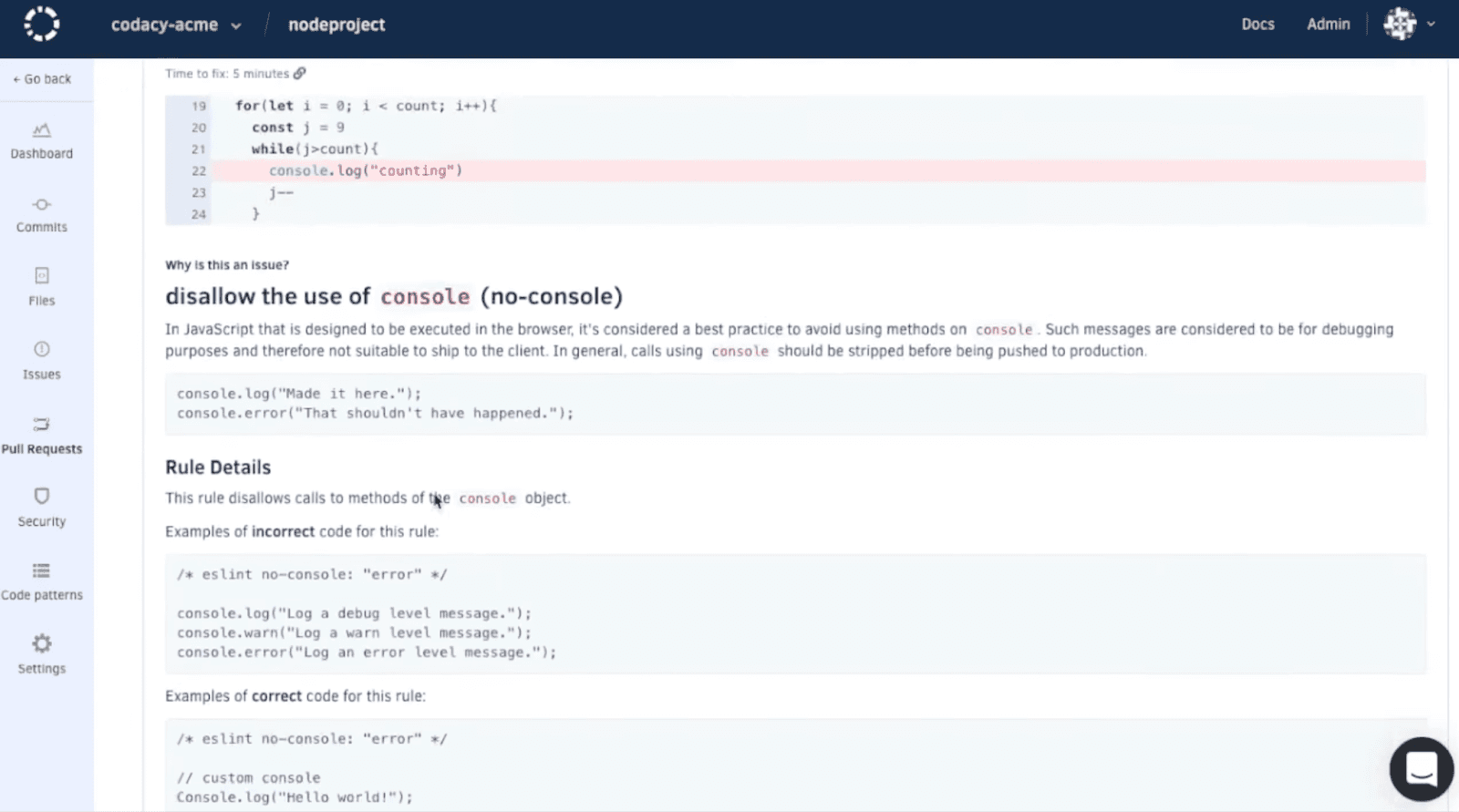
Codacy is a flexible tool designed to help teams improve code quality with automated reviews and support for many programming languages.
It positions itself as a one-stop tool for enforcing quality, security, and maintainability across pull requests and branches. And it works well for teams looking to adjust code analysis to their needs.
However, it does have some drawbacks, like occasional false alerts and high cost at scale, which might make it less favourable for some users.
Why developers like Codacy:
Developers appreciate Codacy for its broad language and rule support as teams with multiple tech stacks can apply consistent quality checks across projects without juggling separate tools.
Many users highlight that Codacy accelerates feedback loops and helps enforce quality at scale.
Pros:
- Offers a clean, easy-to-navigate interface that suits teams of all sizes.
- Works across various programming languages.
- Allows teams to adjust code analysis rules to fit specific project needs.
- Integrates with CI/CD tools like GitHub and GitLab for real-time feedback.
- Automates reviews by commenting on pull requests.
Cons:
- Doesn’t support pre-commit checks locally.
- Occasionally flags false positives, causing unnecessary alerts.
- Pricing can be high for larger teams.
- Some features lack detailed guidelines.
- On-premise versions can face occasional performance issues, while the cloud version is more reliable.
Customer reviews:
Most of the public Codacy reviews are 2 years old on average, but here they are:
- “The automated code review pops up in my mind while thinking about the sides I like much.” – Gartner peer insights
- “I enjoy the quality gates” – G2 reviews
Pricing:
- Free for open source projects and single developers
- Team plans start at $21 per user/month
7. CodeAnt AI

CodeAnt AI combines automation with flexibility, offering tools to detect, fix, and optimize code efficiently. Its integrations and real-time feedback make it a strong option for teams aiming to improve productivity.
Why developers like CodeAnt AI:
Developers are drawn to CodeAnt AI because it offers end-to-end AI-augmented code review combining code quality, security, and PR-level context all in one platform.
Because its AI engine understands abstract syntax trees (ASTs) and connects code context across modules, it can catch issues that isolated linters or rule-based scanners often miss.
Pros:
- Detects and automatically fixes common issues, saving time on code reviews.
- Works with popular IDEs and CI/CD tools like GitHub and Bitbucket.
- Provides immediate feedback during pull requests.
- Lets users adjust analysis rules to match specific coding standards.
- Optimizes code to support scalability for applications that anticipate growth.
Cons:
- Advanced features come at a cost.
- Focuses on cloud-based operations, limiting offline or local analysis options.
- Complex guidelines make it hard to use all the features fully.
- Occasional false positives may occur.
Customer reviews:
“CodeAnt.ai has fundamentally improved how we approach code reviews.” – G2 reviewer.
Pricing:
- Basic plan starts at $12 per user/month
- Premium plan starts at $25 per user/month
Other Honourable Mentions
8. Codiga
9. Codebeat
10. Codegrip
11. Deepsource
12. CodeQL by GitHub
13. Qodo Merge
14. Greptile
15. Devlo.ai
16. Korbit.ai
17. Kodus
18. Gerrit – Fully Open Source
5 Best Code Review Tools for Agile Teams and Startups
Agile teams and startups move fast. From shipping features daily to juggling multiple priorities with limited resources. The code review tool they use must help move fast without breaking the bank.
Also these tools should be quick to set up (founders don’t have time for week-long deployments) and ideally scale with the company’s growth.
Flexibility is also key as a startup might pivot tech stacks or go from on-prem to cloud overnight, so a code review tool that covers multiple environments is a plus.
Here are great options for young companies:
- Aikido Security
- Graphite
- CodeRabbit
- Codacy
- CodeAnt AI
3 Best Code Review Tools for Enterprise Development Teams
Enterprise software development comes with scale, complexity, and strict compliance needs. Code review tools must go beyond bug detection to support governance, security, and cross-team coordination.
Key requirements include:
- Centralized management and policy enforcement for consistent quality standards across teams and repositories.
- Scalability and performance to handle large monorepos, parallel reviews, and high commit volumes.
- Governance and compliance with built-in audit trails and support for frameworks like SOC 2, ISO 27001, and GDPR.
- Security and access control with SSO, SAML, and role-based permissions.
- Integration with enterprise systems such as Jira, Azure DevOps, and CI/CD pipelines.
- Multi-language support to ensure consistent analysis across diverse tech stacks.
- Advanced analytics and reporting to track review metrics and improve engineering efficiency.
In essence, enterprise code review tools must combine governance, scalability, and security while fitting seamlessly into existing workflows.
Here are the top 3 enterprise code review tools:
- Aikido
- SonarQube
- Synk
Find the best AI tool for code review with Aikido Security
Code review has always been the heartbeat of good engineering. And also one of the most hated processes. Between context switching, nitpicking, and endless comment threads, reviews can slow down even the best teams.
Aikido’s code quality makes code reviews smarter and more efficient with its AI code review features. By automating repetitive checks and offering context-aware suggestions, it helps teams focus on improving code quality rather than getting stuck with manual tasks. Its ability to adapt to project-specific needs results in reviews that align perfectly with your system.
Save your dev team valuable time. Try Aikido code quality today!



.avif)
